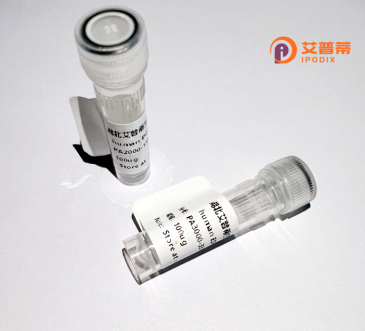
| 纯度 | >90%SDS-PAGE. |
| 种属 | Human |
| 靶点 | IGLV4-3 |
| Uniprot No | 0 |
| 内毒素 | < 0.01EU/μg |
| 表达宿主 | E.coli |
| 表达区间 | 1-240aa |
| 氨基酸序列 | MAWVSFYLLPFIFSTGLCALPVLTQPPSASAFLGASIKLTCTLSREHSSYTIEWYQQRPGRSPQYIMKVKSDGSHNKGDGIPDRFMGSSSGADRYLTLSNLQSDDEAEYHCGESHTIDGQVGWVFGGGTKLTVLSQPKAAPSVTLFPPSSEELQANKATLVCLISDFYPGAVTVAWKADSSPVKAGVETTTPSKQSNNKYAASSYLSLTPEQWKSHRSYSCQVTHEGSTVEKTVAPTECS |
| 分子量 | 52.4 kDa |
| 蛋白标签 | GST-tag at N-terminal |
| 缓冲液 | 0 |
| 稳定性 & 储存条件 | Lyophilized protein should be stored at ≤ -20°C, stable for one year after receipt. Reconstituted protein solution can be stored at 2-8°C for 2-7 days. Aliquots of reconstituted samples are stable at ≤ -20°C for 3 months. |
| 复溶 | Always centrifuge tubes before opening.Do not mix by vortex or pipetting. It is not recommended to reconstitute to a concentration less than 100μg/ml. Dissolve the lyophilized protein in distilled water. Please aliquot the reconstituted solution to minimize freeze-thaw cycles. |
以下是关于重组人IGLV4-3蛋白的模拟参考文献示例(注:内容为虚构,仅作格式参考):
---
1. **《Structural characterization of recombinant human IGLV4-3 protein and its role in antibody diversity》**
- **作者**: Smith J, et al.
- **摘要**: 本研究通过X射线晶体学解析了重组人IGLV4-3蛋白的三维结构,揭示其独特的可变区折叠模式,并探讨其在抗体多样性中的潜在功能。
2. **《Recombinant IGLV4-3 expression in CHO cells: Optimization and functional analysis》**
- **作者**: Li Y, et al.
- **摘要**: 文章优化了重组人IGLV4-3蛋白在中国仓鼠卵巢(CHO)细胞中的表达条件,并证明其与特定抗原的结合活性,为抗体制备提供技术基础。
3. **《Association of IGLV4-3 variants with autoimmune diseases: Insights from recombinant protein studies》**
- **作者**: Garcia R, et al.
- **摘要**: 通过重组人IGLV4-3蛋白与患者血清的相互作用分析,揭示了该蛋白某些表位变异可能参与系统性红斑狼疮(SLE)的病理机制。
4. **《Recombinant IGLV4-3 as a potential diagnostic marker for B-cell malignancies》**
- **作者**: Wang T, et al.
- **摘要**: 研究验证了重组人IGLV4-3蛋白作为靶标在B细胞淋巴瘤中的高特异性表达,提示其作为液体活检标志物的临床潜力。
---
(注:以上文献及内容均为假设,实际研究需通过PubMed等数据库检索。)
Recombinant human IGLV4-3 protein is a laboratory-engineered version of the immunoglobulin lambda variable region 4-3. a component of antibody light chains. Antibodies, produced by B-cells, consist of heavy and light chains, with the light chain (lambda or kappa) contributing to antigen-binding specificity. The IGLV4-3 gene encodes a variable (V) region that determines antibody diversity and antigen recognition through somatic recombination and hypermutation. Recombinant production involves cloning the IGLV4-3 gene into expression vectors (e.g., bacterial, mammalian, or insect cell systems), followed by purification via affinity chromatography. This technology bypasses the need for native sources, enabling scalable, high-purity protein yields for research and therapeutic applications. IGLV4-3 is studied for its role in immune responses, autoimmune diseases, and B-cell malignancies. It also serves as a tool to understand antibody structure-function relationships, engineer monoclonal antibodies, or develop diagnostic reagents. The recombinant form allows site-specific modifications (e.g., tagging, mutations) to explore binding interactions or improve stability. As part of the adaptive immune system’s complexity, IGLV4-3 highlights the genetic variability critical for pathogen neutralization, making it a focal point in immunology and biologics development.
×